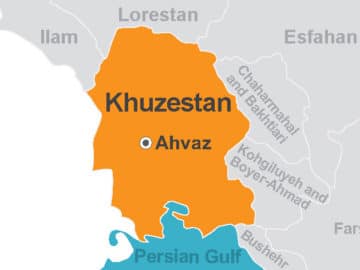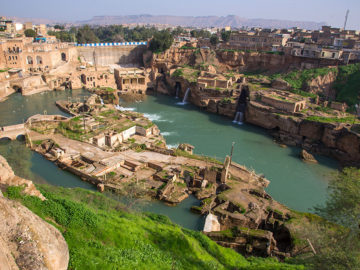Shushtar is one of the main cities of South-West of Iran, at the foothills of Zagros Mountain. After the Arabs invasion, it came to be known as the Believers City. Shushtar is the fourth biggest city of province after Ahvaz. People here speak Farsi with Shushtari dialect, and there are minorities who speak Arabic and Bakhtiary. On entrance to the city, Karoon is divided to different strings that in turn divides the city to three sections. The firs one is Boleity in the East of Gargar River, the next one is located in the North of Shatit River, and the oldest part of the town is like an island, surrounded by the rivers.
Shushtar is believed to mean The Better Shush. When Shush lost its place, when it was on the verge of destroying, Shushtar was made to replace it. The place had better climate than Shush and had a more fertile soil, so it was used for a new city. There are also those who believe the name comes from the word Sheshdar, because the city had 6 gates or Shesh Dar. These six doors were Maparian, Desbol, Adineh, Lashkar, Maqam Ali, and Gargar. There is also this theory that considers the name a changed form of Shah Shater meaning the City of King.
In 2009, a series of constructs in Shushtar were registered under the title of Shushtar Hydraulic System that includes Shadravan Bridge, Mizan Dam, Kolah farangi Tower, Gargar handmade River, Gargar Dam and Bridge, waterfalls and water mills, Borj Ayar Dam, and many other similar constructs.
Although the city we call Shushtar today was probably made in the Sassanid time, the history of living in the area dates back to about 10 thousands years ago. The Elamite experts consider Shushtar as the Adamden city of Elamite Empire. The city is destroyed and a new one replaces it by the order of Achaemenid Kings. In the Greek and Roman texts, the city is referred to as Surkutir and in Arabian text it is known as Tester. The story of how Shadravan Dam is made is retold in Shahnameh as well.
With many excavations performed in the area, objects from prehistoric time, Achaemenid, Parthian and Sassanid dynasties were found. The city experienced its zenith in the Sassanid time. When Valerian, the Emperor of Rome, was defeated by Shapur I of Sassanid dynasty, he and his army were captured and brought to Iran. It is in this time that the magnificent Hydraulic System is made, taking influence from the culture of the captured Romans.

Shushtar was especially popular in the Islamic Era. It became a center of Islamic art, science, culture and education. When the country rose against the caliphs, Shushtar had strategic importance, in a way that getting Shushtar was like getting the whole Khuzestan Region.
In Safavid time, the city grows with the rest of the country. The governor of Shushtar made many constructs and turned the city to one of the most thriving cities of the country. At the early Safavid time, the city fell to chaos because of a religious battle among the followers of a man that claimed to be the 12th Shiite Imam and the government troops. With the claimers being defeated, the city was once again peaceful.
When Nader Shah became the king, the country had fallen apart as a result of Afghan’s attack and the end of Safavid dynasty. In the years that follow his coming to throne many rebellions took place by tribal leaders and rulers that hoped to become independent. Therefore, Nader Shah that wanted to unify the country again was in constant war, suppressing the riots. One of these riots happened in Shushtar, and the city was heavily damaged in the process. Although Nader ordered the reconstruction of the city after the battles, the city already lost a lot.
The religious disputes took another form in the Zand Era, as the two main strings of Mysticism stood against each other. Their disagreements weren’t always hostile, but it took physical form sometimes. The plague that took the city in Qajar time and the death that followed it stopped many things including the religious disputes.
In Pahlavi time, the clergies of the city opposed passing of railway from their city. In this time, the sailing in North Karoon stopped as well which eventually caused the city to lose its place to Ahvaz. Although the city has regained some of its previous fame with the new tourism investments, it is still far from what it once was before.


